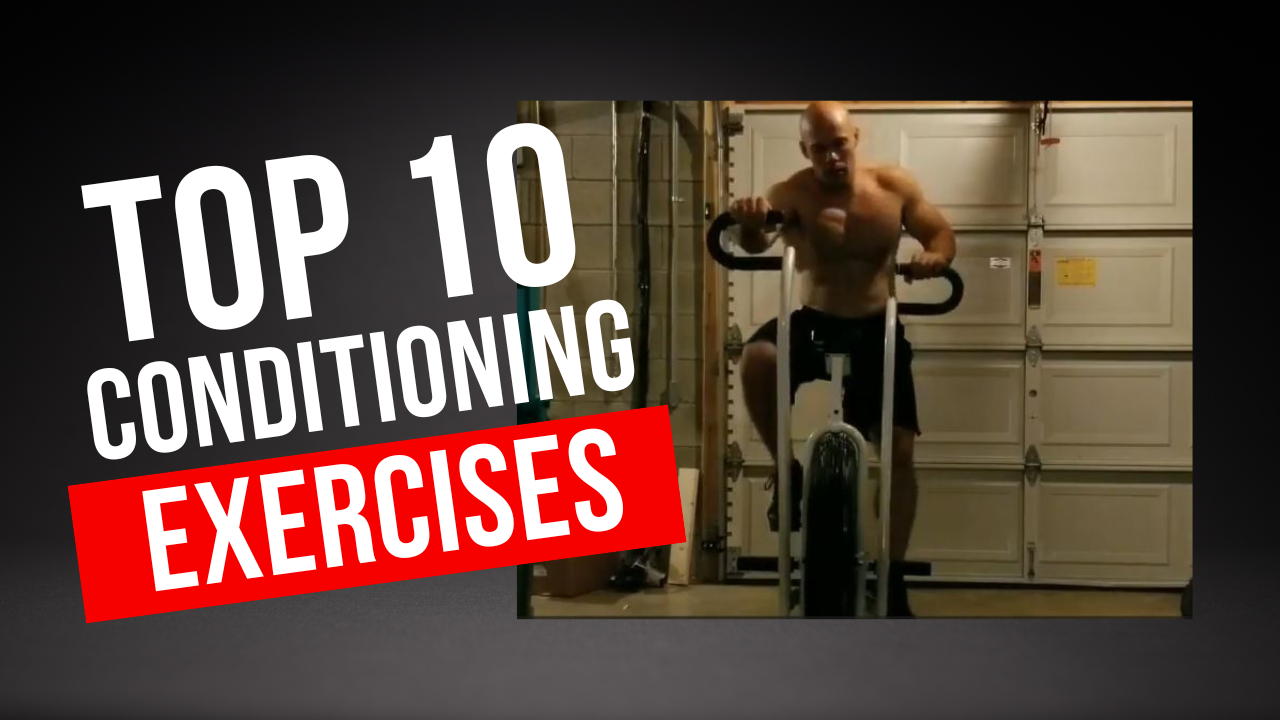The 10 Best Conditioning Exercises for Wrestlers

I am 42 years old, I started serious strength and conditioning when I was 13. That's 29 years of experimentation. Combined with a formal education of 2 degrees and 6 certifications. I also have well over 10,000 hours of coaching. I have tried every training movement and method under the sun. From battle ropes, sledge hammers, and flipping tires, to that stupid swiss ball fad. This list I have provided you here is refined and proven. These are the current movements I use with myself, my own boys, and my athletes to produce world class conditioning.
In order to make my list of "must do" conditioning movements, each movement has to satisfy three criteria.
First, the exercise has to contain a fundamental universal motor recruitment pattern. This means the exercise needs to train and enhance a general skill that wrestler’s need to master like: push, pull, lift, run, jump, squat, lunge and hip flexion.
For example the burpee teaches a general skill, getting down and up off the mat, it is simple but the human body can continuously refine this motor recruitment pattern forever. I have watched over and over again athletes progress through burpee “mastery” starting out clumsy with no endurance, and eventually becoming nimble ninjas that can complete 100+ burpees in a row.
The second criteria is each exercise must satisfy the ability to train the cardiorespiratory system in a dramatic fashion. In other words, wrestlers need to destroy their lungs in training. It has to hurt bad. You need to feel like you are suffocating.
A wrestling match demands a pace that pushes the limits of human physiology. For example, a human can run flat out at near-top speed for only 30-35 seconds due to the depletion of phosphocreatine stores in muscles, and secondarily to excessive metabolic acidosis as a result of anaerobic glycolysis. Yet, a wrestling match lasts on average about 6 minutes. Even though it is impossible to go full speed for 6 minutes no matter your level of conditioning, that is still the goal of a wrestler’s conditioning program.
The third criteria is it needs to be measureable. I cannot stress how important it is to measure your average power output (power = work/time, work = force * distance) for your benchmark conditioners. First, you need a set of benchmark conditioners that you repeat on often to test your progress. CrossFit has a giant list of these at beyondthewhiteboard.com with reliable data to compare your stats to. Just pick a handful of your favorites and repeat them often. Second you need to pick movements that allow you to track time, speed, weight, reps and sets easily.
For example, Clean and Jerks meet all three criteria. They train fundamental skills like power transmission from core to extremities, and the triple extension in squatting and jumping. They will rip your lungs apart very quickly when performed in multiple rep sets. They are also measureable.
Battle ropes however, do not meet all three criteria. First, they are completely unmeasureable. You will never know precisely what your power output was for each set. The fundamental skills battle ropes teach is somewhat useful for wrestlers, but time is better spent on similar and higher priority movements like cleans, snatches, burpees, rowing, ski erg, fan bike etc. And finally, while they are great at destroying the shoulders, they are not the best at pushing the lungs.
As you can see by my comparison of battle ropes to clean and jerks, this top 10 list is very picky. I have run the experiments over and over, slowly gravitating towards certain movements as my "go to's" and leaving other movements in the dust bin.
However, this list is by no means exhaustive. There are plenty of other viable exercises that can and should be incorporated into a wrestling conditioning program. Most other useful movements will be variations of movements on this list. For example Atlas Stone lifts can subsitute cleans, sled push/drag can substitute another full body movement like thrusters, and jump rope for running. Carries like Yolk or Farmer's walks can and should be utilized.
- Burpees: The king of bodyweight exercises, burpees are an excellent way to improve full-body strength and cardiovascular endurance. They teach wrestlers how to quickly get down and spring back up off the mat, a fundamental movement in wrestling. They have the added bonus of no equipment required.
- Rowing and Air Bike: This low-impact, high-intensity exercise works both the upper and lower body, making it a great choice for overall strength and endurance. Incorporating rowing and air bike into your conditioning routine can enhance your pushing and pulling strength, a key skill in wrestling. These machines can be pricey but worth their weight in gold when it comes to building a world class engine.
- Running: Whether it's sprinting or long-distance running, this classic form of cardio is an essential part of any wrestler's training program. It helps build lung capacity, leg strength, and mental toughness. No equipment required!
- Box Jumps: A perfect exercise to build explosive power, agility, and coordination - all vital attributes for a wrestler. Box jumps train your lower body to generate force quickly, a critical ability for executing powerful takedowns. You only need a box!
- Pull-ups, Muscle-Ups, and Rope Climbs: These exercises enhance upper body strength, particularly targeting the back, arms, and grip. These gymnastic movements can be done “strict” or with a “kip”. Remember, a good conditioner means you are moving constantly during the allotted time domain, and breathing must be very difficult due to your high power output per second. If you are doing strict pull-ups and quickly reaching muscular failure, then you will have to stand around and wait for your strength to return in order to continue the conditioner. These rest breaks will destroy the intended stimulus a conditioner and not place enough demand on your cardiorespiratory system. This is where the “kip” becomes useful. The kip turns the pull-up and muscle-up into a full body hip driven power movement. This will help you keep a steady, fast pace throughout your conditioner, allowing you to blow up your lungs.
- Devil's Press: This high-intensity, full-body exercise combines a dumbbell burpee with a double dumbbell snatch, making it a superb choice for improving overall strength, endurance, and metabolic conditioning. These are so potent they can be done by themselves as an effective conditioner.
- Cleans & Jerks / Thrusters: These compound movements work the posterior chain and more, helping to develop functional strength and power. These movements can be done with barbells, dumbbells, kettlebells and heavy medicine balls. When using a heavy medicine ball, 100lbs or more, I modify the clean qby deadlifting the ball off the ground and throwing it over the shoulder. Make sure you alternate shoulders.
- Snatches: This Olympic lift trains power, speed, and coordination, all of which are crucial in wrestling. Snatches can help improve your ability to rapidly generate force, a key aspect of effective takedowns. Snatches can also be done with barbells, kettlebells, and dumbbells. A wrestler should train all variations of the snatch and clean, i.e. power and squat, hang and from the floor, due to the extreme variance in positions a wrestler must be able to fight from.
- Toe-to-Bar: This demanding core exercise also works your grip, shoulders, pecs, lats, and hip flexors. A strong core is essential for maintaining balance and control during a wrestling match. These can be done strict or with a kip. When programming a Toe-to-bar into a conditioner I always use a kip, this enhances the power output, allowing a more steady and fast pace, which in turn places a higher demand on the lungs. (as previously mentioned with the pull-ups and muscle-ups)
- Squats and Lunges: These movements can be done with a variety of equipment or with body weight. Squats and Lunges to maximal depth is a critical skill for wrestlers. I have coached wrestlers who were bad at taking shots or standing up out of the bottom position, who later found out were also bad at squats and lunges. We then fixed their squats and lunges and they became shooting demons and unholdable on bottom.
Example Conditioners
Here are some of my favorite conditioners using the movements from the list. Note how I combine complementary movements together rather than redundant movements.
3 Rounds
1 min Row For Max Calories
1 min Max Burpees
1 min rest
20 minute EMOM
Every minute on the minute perform
3 Power Cleans
3 Front Squats
3 Jerks
*You should be able to complete all 9 reps under 20 seconds, so you will get 40 seconds rest after each 9 rep set. There are 20 sets total! Every time you do this workout add little more weight to the bar. You are trying to find out the max weight you can complete all 20 sets, each set under a minute. The pros can do 205 lbs or more!
10 minute EMOM
6 Devil Press 50lbs dumbbells
*Simply try to complete a total of 60 Devil's Press, doing 6 on the minute every minute for 10 minutes. If or when 6 becomes too easy, use heavier dumbells or add more reps. One Devil's Press resembles a scramble in wrestling.
3 Rounds For time
400m Run
15 Power Snatches 115 lbs
10 Muscle Ups
*On top of ripping your lungs to shreds, this one has the added bonus of training your grip strength. It is ok to drop the bar from overhead after each snatch, and break up the set of 10 muscle-ups into two or 3 sets in order to preserve your grip strength. The muscle-ups will give your legs time to recover for the run. If you blow out your grip early it will not come back easily and destroy your pace. Always remember a fast steady pace is priority number one when conditioning.

